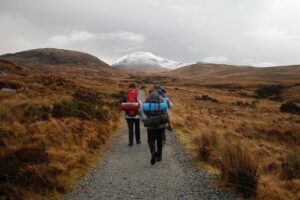Skiing, and all snow sports, are highly weather dependent. Millions of people rely on good snow fall and coverage each year as they head to the mountains to enjoy a skiing holiday.
However, the weather can be a fickle mistress. While good snow underfoot and blue, cloudless, sunny skies make for the perfect skiing conditions, weather changes on the slopes can have a significant impact on skiers, and they will need to make changes to their approach depending on the weather conditions at the time. Keep reading to find out more.

Table of Contents
Types of Snow
Snow comes in many forms, and the type of snow found on the mountainsides can dictate the quality of the skiing to be had there.
Powdered snow is generally the most desirable type there is. This is the freshest, most recently fallen, untouched snow that provides the smoothest skiing surface. It’s the best for generating speed and, for the experienced skier, making sharp turns and executing impressive tricks. It’s incredibly soft, so provides a forgiving cushion should a skier fall. However, this softness can also cause problems, remain too stationary on powdered snow and you could begin to sink and have to dig yourself back out again.
Packed snow is the name given to powdered snow that has seen heavy traffic over the course of a day’s skiing. It becomes tough and compact, far more solid and heavier than the fresh powdered snow. Packed snow can provide a more stable surface than powdered, so it may suit beginners, however as packed snow is harder it can make for more painful falls.
Temperature
The temperature on the slopes can have an effect on skiing too. Not only will it determine the quality and longevity of the snow, but it will also dictate how you should dress and prepare for a day on the mountainside.
Ideally, the perfect skiing temperature is generally between -7 degrees Celsius to -1 degrees Celsius. In this temperature range, the snow will not melt and turn slushy, while it is still warm enough for skiers to remain comfortable (if dressed appropriately) throughout the day.
Sunlight
The perfect skiing weather combination is fresh, powdered snow underfoot and sunny, blue skies above. The contrast makes for an idyllic scene, perfect for taking photos or simply taking in stunning views.
However, the sun can cause some problems. Sunlight reflecting off of the whiteness of the snow can dazzle skiers, causing something called snow blindness. This can severely impede skiers’ vision which, when involved with a high-risk activity like skiing, can lead to some extremely perilous and even life-threatening situations.
Be Prepared
The best thing to do to ensure you’re prepared for any weather eventuality is to check the forecasts ahead of time. Visit Piste Pro, they have comprehensive weather forecasts and information for a range of global skiing locations, as well as additional slope and resort information for wherever your ski trip is taking you.
Conclusion
Few sports are as dependent on specific weather conditions as skiing. While indoor slopes with fake or even real snow are available, during the winter months most skiers will want to experience the real thing, and millions flock to the thousands of resorts throughout the world to make the most of the snow while it’s there.
There are subtle differences that can have a major influence on how the snow feels underfoot and how skiers should approach the slopes. Being aware of the different types of snow and the optimum temperatures will give you a good idea of the best conditions, while checking forecasts ahead of time will allow you to prepare for what lies ahead.




